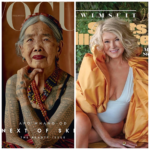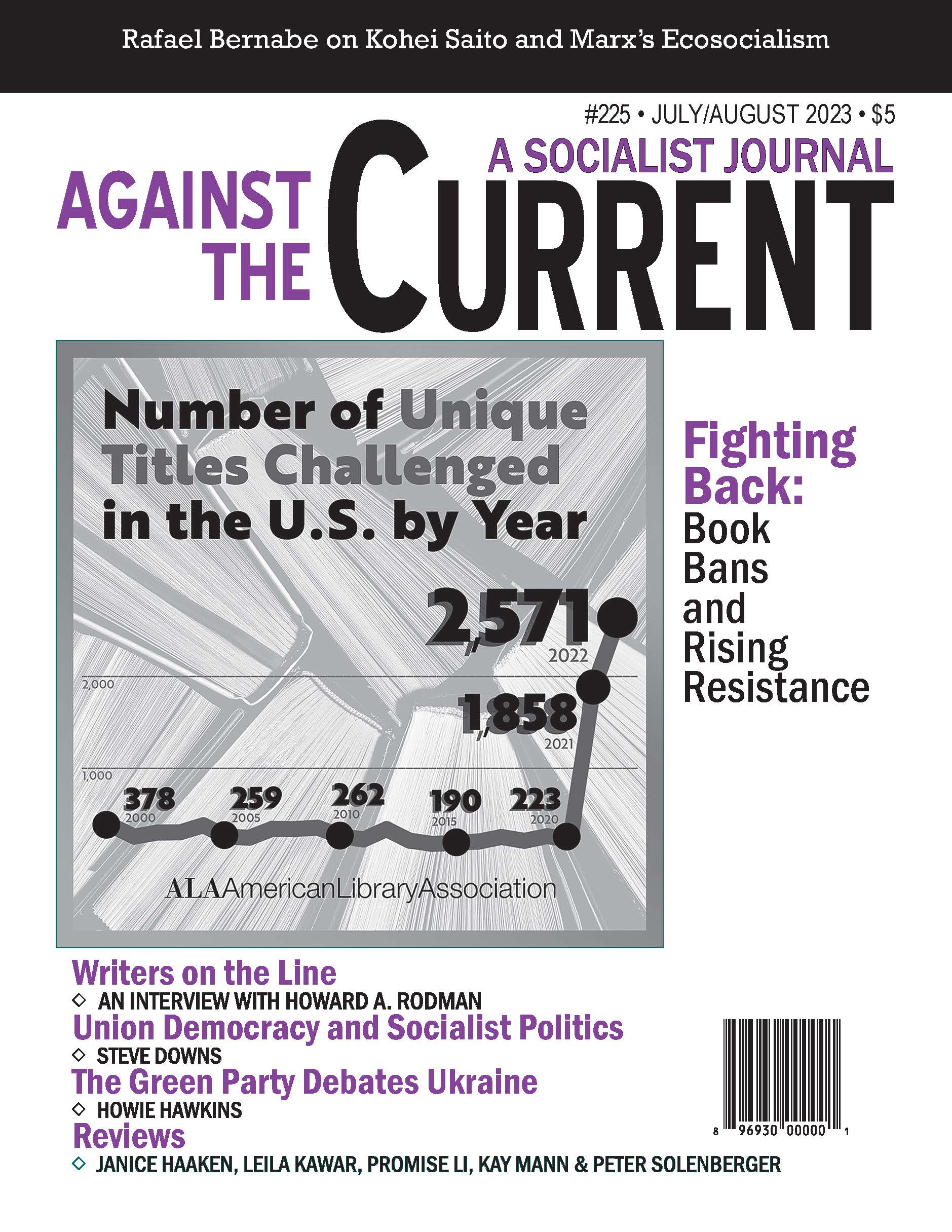Against the Current No. 225, July/August 2023
-
"Noise as Usual" -- Or Crisis Now?
— The Editors -
Cruelty at the U.S.-Mexico Border
— Malik Miah - Gary Tyler Fundraiser
-
Paving the Way for Le Pen?
— Gerd-Rainer Horn -
Keith LaMar: A Struggle for Life and Freedom
— David Finkel -
Libraries Under Attack
— Mark Weber -
Our Movement of Rising Resistance
— Harvey J. Graff - In Support of Fatima Mohammed
-
The Green Party Debates Ukraine
— Howie Hawkins - Ukraine Peace Appeal: Toward a More Informed Solidarity
-
Commodification and Colonialism
— Delia D. Aguilar - Resistance to Restructuring
-
The UPS Contract Campaign
— Jack Martin -
The Writers Guild Strike
— Alan Minsky interviews Howard A. Rodman -
Socialists and Union Democracy
— Steve Downs -
Contingent and Powerful
— Kay Mann - Review Essay
-
Saito, Marx and the Anthropocene
— Rafael Bernabe - Reviews
-
Trauma, Psychiatry and the War on Terror
— Janice Haaken -
Hidden History of the New Cold War
— Peter Solenberger -
China's Unarmed Prophets
— Promise Li -
Meanings of Palestinian Peoplehood
— Leila Kawar
Delia D. Aguilar

MY FIRST REACTION when I saw the side-by-side photos of 106-year-old Igorot tattoo artist Apo Whang-od and that of U.S. business mogul and household name Martha Stewart: is this a joke?
If so, it wasn’t funny to me. No doubt it didn’t matter a bit to Martha Stewart, accustomed to and thriving, in fact, on commodification.
But Whang-od’s picture — ruby-red lips, chin resting on thumb, affecting a model’s pose, likely contrived by her Vogue magazine handlers to justify the caption “Next of Skin, The Beauty issue” — promptly brought to mind the utterly shameless display and exotification of her forebears in the now infamous 1904 Louisiana Purchase Exposition or St. Louis World Fair.
Pronounced by the properly enlightened today as “human zoos,” the purpose of the exhibit at the time was to demonstrate the superiority of white U.S. civilization against the backwardness of G-stringed natives shipped in from what was then the faraway “Philippine Islands.”
This unfortunate juxtaposition of glamorized pictures was posted in Facebook’s “Feminist News,” subheaded “Smashing the Patriarchy” and counting 1.8 million followers. Obviously its youthful feminist subscribers had no knowledge of Igorots, much less their history of struggle, nor heard about the horrid World’s Fair exhibit — only, perhaps, what was provided in the article in Vogue where Whang-od was the cover icon.
Detached from History
In her preface to the Facebook discussion, the author did state that Whang-od was a tattoo artist, but it seems that was immaterial to her readers.
Detached from history and geography, what was of interest to its feminist readers were the competing images of the two, both of “a certain age.” Here Whang-od at 106 emerges the undeniable winner; after all, Sports Illustrated Swimsuit edition cover Martha Stewart is only 81. Plus maybe, as some FB contributors offered, the influencer whom everyone recognizes has gotten some help — that is, aside from “organic homegrown farm-to-table eating” — to keep that skin taut and glowing.
Moreover, while “anti-aging cannot be a beauty standard,” apparently “authenticity” is. What better evidence of this than the wisdom projected by every “stunning wrinkle and frown line” of the centenarian? Overall, the call and direction of the commentary was to reject ageist stereotypes.
And so it was that in this contest of physical attributes — dare we call it senior pulchritude? — the Igorot artist ran off with the gold. This was the theme harped upon by practically all the FB responses, 774+ of them, each one in some way praising Whang-od’s “amazing beauty” and almost entirely ignoring poor Martha Stewart.
Not only was Vogue lauded for its “great choice” because, as someone gushed, “she’s the most beautiful woman I’ve ever seen,” with another suggesting that “Asian food must have contributed to her stunning appearance.” And how about this for its unknowing nod toward orientalism: “I don’t like feminists, but this is a great post.”
The magic of social media succeeded in projecting Whang-od and Martha Stewart as equals to be put on stage and compared, an act that contravened their actual worlds, in reality exceedingly distinct and separate in every possible way.
Colonial Elephant in the Room
Seeking relief and wishing to push out of mind disturbing images of Igorot Village redux, I turned to a Filipino audience and re-posted the Feminist News item with the photos on my page.
I pre-empted vapid comments such as the “debunking of youthful beauty standards” by stating outright that I thought the photos’ side-by-side positioning was utterly ridiculous, out of whack, and invited parody. Still, someone wrote that she “identified more with the lovely tattooed woman than the cosmopolitan lady,” and another remarked that Whang-od could well be Martha Stewart’s mother.
To my great delight economist Agnes Quisumbing summed up the main issue in one simple succinct statement: “The commentary invites us to reject ageist stereotypes, but the elephant in the room is colonialism,” adding that “we wear different identities at once, not all of them visible.”
What she references in the latter is identity politics or the politics of representation that I will pick up on later. But the elephant in the room, I strongly agree, has to be addressed head-on for any further discussion to make sense.
Had colonization and national subjugation been used as the larger narrative or frame within which to situate the story of Whang-od, the facile comparison with Martha Stewart would have been both inept and egregiously condescending. In its absence, the focus of attention is on the two individuals as though they stand by themselves removed from their respective societies. Needless to say, this individualist view is how we are all encouraged to see the world.
The individual-centered approach is what my friend and colleague, educator May Penuela, was to critique when she turned to the Vogue article written by Audrey Carpio to see how Whang-od was portrayed.
She is a fashionista! Hewing close to the style magazine’s beauty theme (a vast departure from the politicized teen Vogue), the Igorot elder is described as “dressed in her usual accidental hipster grandma style, wearing a puffy bomber over track pants and a paisley bandana around her forehead.”
May observes the way the author reaffirms this hipster act in yet another astonishing description: “I had found Whang-od, gangster as ever, hanging out by a giant golden statue of herself, under whose outstretched arms and bare breasts I received my three dots.”
Here the appeal of Whang-od becomes undisguised. She is unabashedly the indigenous exotic, half-naked, just like her dog-eating, head-hunting forebears housed in the “villages” built for them in St. Louis, with the notable exception that now she’s attired urban gangsta-style. Can our tribal woman be any more postmodern?
May brilliantly suggests, reflecting on the Vogue article:
“If Architectural Digest did a profile comparison of both women in front of their homes and land, perhaps the off-kilter comparison would be too obvious. And some feminists would not consider them women’s issues. I don’t recall any discussion of Igorot land struggles when Whang-od’s cover story went viral. The Vogue story itself focused on the Kalinga tattoo tradition and struggle for representation, using American slang to make Whang-od more appealing to a hip and trendy reading audience.”
The Enduring Igorot Struggle
It’s hard to argue with May here, speaking of so much in so little space. White feminists could be forgiven for their ignorance about the Igorots who resisted 350 years of Spanish colonization, staged the most valiant attack against the Japanese in World War II, and today mostly live in poverty as they continue the centuries-long struggle of holding onto their mineral-rich land eternally threatened by resource-grabbing corporations.
As May guesses, mention of such facts might well be straying away from the usual feminist concerns.
The politics of representation, what Agnes cites as “the many identities we wear, not all of them visible,” also becomes a problem and a distraction, even in its widely endorsed formula of “intersectionality.”
In the interplay of multiple forms of domination, all conditions of oppression become equally significant, each one vying for attention in a competitive capitalist marketplace. Moreover, so long as capitalism’s existence is deemed permanent, no amount of tweaking individual identities becomes consequential.
While the Vogue writer may not necessarily be fully tuned in to the Igorots’ enduring history of struggle, she is certainly aware of the tourist industry’s crass commercialization of the old woman’s art, and worse, her person. Citing a case where the National Commission on Indigenous Peoples had to be called upon to intervene, she takes a stand against cultural appropriation, summoning “decolonizing aesthetics” and “control of our bodies,” whatever these phrases may mean under current conditions.
Apo Whang-od and her art deserve to be honored. It is a shame that she is once again put on display just as her precursors were, as she grinds out a living and preserves her people’s art. Ironically, it is precisely the centuries-long honorable and valiant stand of the Igorots — their fierce independence and unwillingness to succumb to foreign subjugation — that up to now serve as the beacon and inspiration for the rest of us Filipinos.
July-August 2023, ATC 225


excellent powerful expose of imperialist commodification of colonized, exploited people of color!